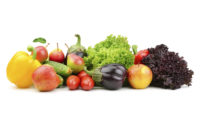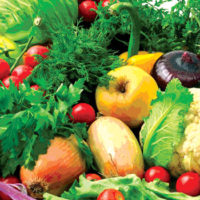British Columbia (BC) farmers’ markets offer foods sourced directly from farms, people’s homes or prepared in commercial kitchens and/or licensed plants. Approval for vendors to sell their foods at a market involves a review of the application by the farmers’ market manager, who will screen and pass along to environmental health officers (EHOs) any applications with recipes that involve potentially hazardous food (PHF) for approval. The classic criteria to determine which foods are PHF are low acid (pH > 4.6) or moist (Aw > 0.85) foods capable of supporting bacterial growth. How the foods are packaged, labeled and stored also help determine whether a food is a PHF. Because PHFs are more likely to be contaminated, these foods are considered higher risk and must be prepared in a commercial kitchen, whereas non-PHFs are considered lower risk and can be prepared at home. For example, cheese made in a person’s home would not be approved because it is PHF, but cheese made in a licensed, inspected dairy plant on a farm would be approved. This seems straight forward but verifying the types of foods that are lower risk and may be made safely in an uninspected home can be challenging.
To help people decide what foods may be made at home and sold in farmers’ markets, BC uses the Guideline for the Sale of Foods at Temporary Food Markets to categorize foods based on whether they are low risk or higher risk (PHF). While this guideline provides direction, market managers and EHOs are often faced with reviewing foods not listed in the guideline and establishing if the food is low-risk and allowed to be prepared at home; if the food is higher risk and preparation must occur in a commercial kitchen; or if the food should not be allowed for sale at all. An evaluation of farmers’ market managers and EHOs handling of market applications found there was significant difference between market managers and EHOs whether food would be accepted for sale (P < 0.001). Managers accepted foods for sale more often than EHOs, whereas knowledge about what risks to look for in an application was below 40 percent in both groups.[1] However, the safety of a food cannot always be verified even when the application contains a photo of the food with a label, recipe, and lab report with the food’s pH and/or Aw. Questions about process safety and the sanitary quality of the environment and handling of the food are additional important considerations for PHF approvals.
Food issues encountered in farmers’ market applications:
• Evaluating if the food ingredients and processes are high risk (raw carob/cocoa vs. heat-treated carob/cocoa)
• Being unfamiliar with the process or ingredients, or not enough is known to determine risk (microgreens risk in comparison to sprout risks)
• Minimizing process risk, for example, during fermentation or in raw food diets when food is dehydrated at temperatures lower than 145 °F (63 °C)
.png) To keep the guideline up to date, farmers’ markets and their association meet with EHOs annually to discuss issues and whether any changes to the food categories need to be made. Food issue decisions (Table 1) can result in foods being allowed for sale that weren’t previously, for example, microgreens, or conditionally approved if preparation occurs in a commercial kitchen, for example, sauerkraut. The system still isn’t perfect. We learned that vendors wanting to make sauerkraut for farmers’ markets want to comply, but there is no storage capacity in commercial kitchens to leave products there while the fermentation occurs. Potential cross-contamination and unsanitary conditions could occur during transportation of incompletely fermented products back to a vendor’s home, or in the commercial kitchen where multiple users have access to the fermenting products when the vendor is absent.
To keep the guideline up to date, farmers’ markets and their association meet with EHOs annually to discuss issues and whether any changes to the food categories need to be made. Food issue decisions (Table 1) can result in foods being allowed for sale that weren’t previously, for example, microgreens, or conditionally approved if preparation occurs in a commercial kitchen, for example, sauerkraut. The system still isn’t perfect. We learned that vendors wanting to make sauerkraut for farmers’ markets want to comply, but there is no storage capacity in commercial kitchens to leave products there while the fermentation occurs. Potential cross-contamination and unsanitary conditions could occur during transportation of incompletely fermented products back to a vendor’s home, or in the commercial kitchen where multiple users have access to the fermenting products when the vendor is absent.
When a lifestyle food choice, such as raw diet food is sold, farmers’ market managers and EHOs may not recognize the risk depending on the appearance of the vendor application. For example, “onion bread” with a final water activity of 0.54 first appears to be a low risk food. However, closer examination of the process reveals sprouted sunflower and flax seeds are mixed with chopped onions and dehydrated for 10 hours at 105 °F (41 °C). We are in the process of making recommendations on minimizing risks in raw diet foods, a difficult task made even harder in the absence of scientific research into this area. In the meantime, EHOs are left with having to take a decision on whether to approve these products to be made at home, while farmers’ markets assume a potential liability risk for these products.
Resources for Food Safety and Farmers’ Markets
BC Temporary food market guidelines (Low risk food examples allowed for sale are shown in Appendix I, high risk foods in Appendix II)
Food issue notes (food issues referred to in the table are listed along with many others)
MarketSafe education (an online education course for farmers’ market vendors and managers)
Good Farmers’ Market Practices (best practices for farmers’ markets)
Food Safety Matters (food safety and management at farmers’ markets, with helpful checklists)
Lorraine McIntyre, M.Sc., is a food safety specialist in the Environmental Health Services at the BC Centre for Disease Control.
Reference
1. McIntyre L, et al. 2014. “Competencies of Those Assessing Food Safety Risks of Foods for Sale at Farmers’ Markets in British Columbia, Canada.” Food Prot Trends 34(5):331–348.




